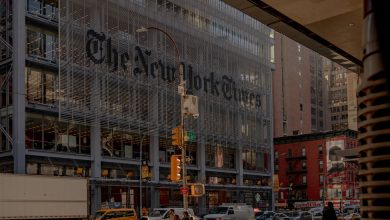The Writer Who Brought Real-Life Brooklyn to Soap Operas

Growing up in the 1970s and early 1980s, that great period of parental absenteeism, I spent most weekday afternoons on the floor of my grandmother’s bedroom in front of a small television that sat next to the door to her veranda, a sunlit space covered in wisteria that still could not compete with the pleasures of ABC’s daytime lineup.
Home by 3, I could join my grandmother for “General Hospital” and, later, “The Edge of Night,” whose story lines bent toward crime and courtroom drama but nevertheless accommodated the absurdist narrative mandates of soap opera.
A chilly and practical immigrant who spent her evenings writing poetry in her native Sicilian dialect, my grandmother was an unlikely candidate for addiction to the Amnesia Plot, but there we were, picking at butter cookies, enthralled every time another socialite with a split personality couldn’t remember the murder she committed when she was someone else with darker hair.
At the time, nearly every soap on television was set in a fictional affluent suburb — to my mind, always in eastern Pennsylvania — dominated by some wealthy Protestant clan or another. It became clear years later that my grandmother’s pristine English, delivered as if she had entered the world via the Main Line, was the result of her daily ritual.
One summer in the late ’70s, I discovered a new daytime series — ‘‘Ryan’s Hope” — but I couldn’t get her on board. It dealt with the generational tension between Old World cultural and religious values and the new freedoms embraced by the young; the modernity did not appeal to her.
Lacking the deracinated quality of the others, the show was set in a city — an actual one, New York — specifically in Washington Heights, amid a Catholic, working-class Irish American family whose matriarch, Maeve Ryan (played by the Tony Award-winning actress Helen Gallagher), loved Yeats and spoke with a brogue.
This and other aspects of the show felt revolutionary. Unlike most soaps, which were claustrophobic, “Ryan’s Hope” let the world in. It was grounded in a reality — about women’s actual lives — that the genre had otherwise disavowed.
Maeve and her husband owned a bar and had five children; one of them, Mary Ryan, was named after a real person: a Brooklyn writer. Married to a lawyer she met when she was getting a master’s degree in literature at Yale, the real Mary Ryan (Mary Ryan Munisteri by way of marriage) bought a brownstone in Park Slope in the late 1960s. It was there, through a local church, that she met Claire Labine, who encouraged her to write for television.
She began writing skits for “Sesame Street” and “The Electric Company.” Then, in 1975, Ms. Labine and a partner created “Ryan’s Hope” and quickly brought Mary on to write dialogue.
By the early ’80s, Mary was the show’s head writer and had won seven Emmys. Before she died last month at the age of 82, she was the last surviving member of a creative triumvirate that had made the show such a success.
The fictional Mary Ryan, for example, was an ambitious journalist who stood up to a temperamental husband who did not want her to put career over family. When her brother Frank runs for a Senate seat, he struggles to balance his obligations to his campaign with the ones he has to his baby.
The show reveled in local political detail, making Frank take a position on Westway, the West Side Highway project that was sidelined after years of debate. There was mention of issues and feuds among district leaders and donors in Nassau County.
One character, a politician named Charlie Ferris, was thought to be an amalgam of a state assemblyman named Joe Ferris, who represented Park Slope at the time, and a familiar reform Democrat, Charles Monaghan. Another character had slipped under the radar of immigration officials and faced the threat of deportation to Ireland.
There were sophisticated nods and winks throughout; another character, Stanley Bosworth, was named after the founder and head of St. Ann’s, the private school in Brooklyn Heights where Mary’s children were enrolled.
The writers had no interest in condescending to a female audience. This in itself seemed novel, given that by 1981 “General Hospital” had a plot in which a family of rich lunatics was building a weather machine to freeze the planet and take over the world. In the beginning and for a long stretch, “Ryan’s Hope” benefited from network neglect.
“We worked in a studio on 53rd Street between Ninth and Tenth, which was not the best place to be working at the time, but what was good about it was that the executives didn’t want to go there either, so they’d leave us alone,” said Jeffrey Lane, who was mentored by Ms. Ryan Munisteri and Ms. Labine and who went on to write for popular prime-time series like “Mad About You.”
The network did occasionally interfere. Once, the writers wound up with a plotline in which a gorilla, escaped from the Central Park Zoo, kidnaps one of the female leads and takes her to the top of Belvedere Castle. This turned out not to be good for ratings, Mr. Lane said, because the craziness was so out of step with the show’s ethos.
Until the mid-1980s, with the rise of comedies like “Designing Women,” prime-time writers’ rooms were not the easiest spaces for women to penetrate. This left daytime television as a refuge, a place where women could wield a lot of creative power and work in a way that suited their personal circumstance.
“There was a real integration of work life and home life that is common now but wasn’t then,’’ Mary’s son Matt Munisteri, a jazz guitarist, told me recently. “We were all in the Slope,” he said — the Labines on Berkeley Place, the Munisteris on Carroll Street. “At night, my mom would be writing and on deadline, and the kids would go back and forth as messengers with scripts.”
“Whenever the children were home from school during lunchtime, they would all gather at the Labine apartment to watch “Ryan’s Hope,” which aired at 12:30, he said. “When the show was on, you couldn’t speak.”
I contacted Matt, whom I knew through friends in college, when I learned that his mother had died. I had met her once in the ’80s in her apartment in a Rosario Candela building overlooking Prospect Park. She was the first professional writer I had ever met, and she was dazzling. Mary went on to run writers’ rooms for several other soaps for many years. I asked Matt if she ever wished she had written more broadly.
A grandchild of traveling vaudevillians, she never felt as though she was doing something beneath her. “When she’d sit writing dialogue, she’d be mouthing it, and her fingers were flying on the keyboard, and you’d walk in the door and you’d just be ignored, ignored, ignored,” Matt told me.
“She had no tolerance for looking down on any kind of art as lowbrow,” he said. “It’s difficult for people to understand — but she loved it.”





